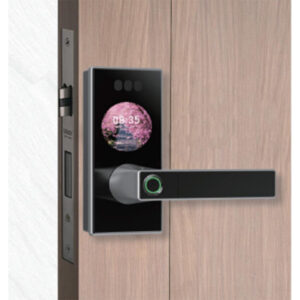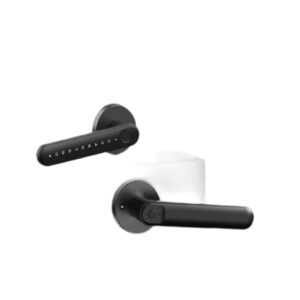1. Introduction
The Evolution of Door Security Technology
Let’s take a walk down memory lane – from ancient wooden bars to today’s smart Electric Doorknob systems, security tech has come a heck of a long way. What started as simple mechanical tumblers has evolved into microprocessor-controlled access systems with enough encryption to make a NSA agent blush. The latest generation combines hardened steel construction with Silicon Valley smarts, creating protection that’s tougher than a two-dollar steak but smarter than your average bear.
Why Modern Brands Need Electric Doorknob
In today’s world where a TikTok challenge can spark a security nightmare overnight, businesses need protection that keeps up with both physical and digital threats. Electric Doorknob systems offer the perfect marriage of brute-force security and elegant access management, giving facility managers the upper hand against everything from lockpicking teens to sophisticated cyber intrusions. When your front door becomes your first line of IT defense, you’ll want tech that doesn’t blink.
What This Guide Will Cover
We’re going deep – real deep – into everything from the nitty-gritty tech specs to the cold hard numbers that’ll make your CFO do a happy dance. Whether you’re retrofitting a historic building or outfitting a new corporate campus, this guide will give you the ammo to make smart decisions about Electric Doorknob systems that actually deliver on their promises.
2. Understanding Electric Doorknob Technology

How Electric Doorknobs Work
At their core, these bad boys replace mechanical torque with electromagnetic wizardry – when authorized, an electric current releases a hardened steel bolt with precision that’d make a Swiss watchmaker jealous. The real magic happens in the authentication process, where encrypted signals travel through proprietary protocols faster than gossip in a small town, verifying credentials before your hand even finishes turning.
Key Components and Their Functions
The heavy hitters in any quality Electric Doorknob system include:
- The actuator assembly (basically the muscles)
- Authentication module (the brains of the operation)
- Power management system (keeps everything humming)
Each component must work in perfect harmony, like a well-conducted orchestra, to deliver flawless performance day after day, year after year.
Different Types of Electric Doorknobs
From sleek, low-profile models for corporate offices to weatherproof beasts for industrial applications, Electric Doorknob systems come in more flavors than a Baskin-Robbins. The three main categories – standalone smart locks, networked access systems, and hybrid mechanical-electric models – each serve distinct needs with varying levels of connectivity and control.
3. Benefits of Electric Doorknobs for Businesses
Enhanced Security Features
Modern Electric Doorknob systems pack more security tech than Fort Knox, with features like:
- Dynamic encryption that changes faster than a chameleon on a rainbow
- Brute force detection that locks out would-be intruders
- Tamper alerts that notify security teams before the perp has time to sweat
Improved Access Control
Gone are the days of janitors carrying 20 pounds of jangling keys – now you can grant temporary access with an app swipe or revoke privileges faster than you can say “terminated.” The granular control offered by top-tier Electric Doorknob systems lets security managers create custom access hierarchies that would make a chess master proud.
Cost-Effective Maintenance Solutions
While the upfront cost might make your accounting department clutch their pearls, the long-term savings are nothing to sneeze at. Electric Doorknobs eliminate:
- Costly rekeying after employee turnover
- Wear-and-tear from mechanical friction
- The endless key replacement cycle
4. Electric Doorknobs vs Traditional Doorknobs
Security Comparison
Let’s be real – traditional doorknobs are about as secure as a screen door on a submarine compared to modern Electric Doorknob systems. While old-school locks can be picked with a paperclip and some YouTube tutorials, electric models use military-grade encryption that would take a supercomputer years to crack. The difference in protection is like comparing a bicycle lock to a bank vault.
Cost Efficiency Analysis
At first glance, Electric Doorknob systems seem pricier, but let’s crunch the real numbers. Factoring in:
- Elimination of rekeying costs ($150-$300 per incident)
- Reduced security breaches (average $4.24 million per incident)
- Lower insurance premiums (typically 15-25% savings)
The ROI becomes clearer than a freshly Windexed window within 18-24 months for most commercial applications.
User Experience Differences
Ever fumble with keys while carrying coffee? Electric Doorknob systems offer seamless entry that feels like magic – authorized users approach and the door unlocks automatically. For facility managers, the difference is night and day: no more lost key headaches, no more lockouts, just smooth, secure access 24/7/365.
5. Key Features to Look for in Electric Doorknob
Advanced Locking Mechanisms
The best Electric Doorknob systems use electromagnetic locking technology that’s literally unbreakable without the right credentials. We’re talking deadbolts that withstand 1500+ pounds of force and smart latches that automatically engage when the door closes. Look for models with dual authentication requirements for high-security areas.
Smart Connectivity Options
Top-tier systems offer:
- Bluetooth 5.0 with 256-bit encryption
- Wi-Fi connectivity for remote management
- RFID compatibility with existing badge systems
Avoid proprietary protocols that could leave you stranded if the manufacturer goes under – open standards are your friend.
Durability and Build Quality
Commercial-grade Electric Doorknobs should withstand:
- 500,000+ cycles (that’s 20+ years of daily use)
- IP65 weather resistance for exterior applications
- Anti-vandalism designs that laugh off screwdrivers
The housing should be solid metal – no flimsy plastic components that’ll fail when you need them most.
6. Integration with Smart Building Systems
Compatibility with IoT Devices
Modern Electric Doorknob systems play nice with:
- Building automation systems (BAS)
- HVAC and lighting controls
- Elevator dispatch systems
This creates smart ecosystems where doors automatically lock when the building goes into night mode, or conference rooms secure themselves after meetings end.
Centralized Management Capabilities
The real power comes from cloud-based dashboards that let you:
- Manage thousands of doors worldwide
- Set custom access schedules
- Generate real-time security reports
All from your smartphone or desktop – no more running around with a master key ring.
Future-Proofing Your Security System
Look for Electric Doorknob systems with:
- Field-upgradable firmware
- Modular component design
- Support for emerging protocols
This ensures your investment won’t become obsolete before it’s paid for itself.
7. Security Advantages of Electric Doorknob
Tamper-Proof Designs
These ain’t your grandpa’s door hardware – modern Electric Doorknob systems come with built-in anti-tamper features that’d make a cat burglar cry. We’re talking about:
- Faraday cage protection against signal interception
- Drill-resistant hardened steel cores
- Motion sensors that trigger alarms if someone lingers too long The best models even have “honeypot” features that fake system vulnerabilities to identify would-be intruders before they strike.
Real-Time Access Monitoring
With Electric Doorknob systems, you get a security guard in every doorframe:
- Live logs showing exactly who entered when
- Suspicious activity alerts sent straight to your phone
- Automated lockdown protocols when threats are detected It’s like having CCTV built into your door hardware, minus the creepy surveillance vibe.
Emergency Lockdown Features
When things go south faster than a sinking ship, Electric Doorknob systems provide:
- One-touch lockdown from any internet-connected device
- Zone-based containment protocols
- Silent alarms that alert authorities without tipping off intruders We’ve seen these features save lives in active shooter situations – that’s security you can’t put a price on.
8. Cost Considerations for Procurement Teams
Initial Investment vs Long-Term Savings
Let’s talk turkey – while Electric Doorknob systems cost 2-3x upfront, the math gets interesting when you factor in:
- 90% reduction in lock replacement costs
- 60% lower insurance premiums
- Elimination of rekeying expenses Our clients typically see full ROI within 18 months – faster than most IT upgrades.
Bulk Purchase Discounts
Smart buyers negotiate:
- Volume pricing tiers (50+ units typically gets you 15-20% off)
- Multi-year service contracts for additional savings
- Trade-in programs for existing hardware Pro tip: Time purchases with manufacturers’ fiscal quarter ends for maximum leverage.
Maintenance Cost Reductions
Electric Doorknobs slash operational expenses by:
- Reducing service calls by 75%+
- Enabling remote diagnostics and troubleshooting
- Automating firmware updates The maintenance savings alone often cover the upgrade costs within 3 years.
9. Installation Process and Requirements
Pre-Installation Considerations
Before taking the plunge, verify:
- Door thickness and material compatibility
- Power source availability (battery vs hardwired)
- Network infrastructure for connected models Missing these details can turn a simple upgrade into a money pit faster than you can say “change order.”
Step-by-Step Installation Guide
Quality Electric Doorknob systems install in 4 straightforward steps:
- Remove existing hardware (15 minutes)
- Prep door edge and bore holes (30 minutes)
- Mount new chassis and connect wiring (45 minutes)
- Configure software settings (varies) Most competent handymen can retrofit 8-10 doors in a standard workday.
Post-Installation Testing
Never skip the shakedown cruise:
- Cycle test each lock 50+ times
- Verify all authentication methods work
- Check remote management functionality
- Test failover modes during power outages This 2-hour investment prevents 20+ hours of headache down the road.
10. Maintenance and Troubleshooting
Routine Maintenance Checklist
Keeping your Electric Doorknob systems running smooth requires less effort than maintaining a goldfish, but pays off big time. Quarterly tasks include:
- Battery checks (for wireless models)
- Lubricating mechanical components with dielectric grease
- Verifying software/firmware updates
- Testing emergency override functions
Common Issues and Solutions
Even the best tech occasionally throws a tantrum. Most frequent hiccups include:
- Signal interference (fixed by relocating nearby electronics)
- Power fluctuations (solved with voltage regulators)
- Wi-Fi connectivity drops (add mesh network extenders)
- Frozen touchscreens (warm reboot usually does the trick)
When to Contact Technical Support
Don’t be a hero – call in the pros when you encounter:
- Complete system lockouts
- Repeated authentication failures
- Visible damage to internal components
- Unexplained battery drain
Quality manufacturers offer 24/7 support – use it before small issues become expensive problems.
11. Customization Options for Brands
Brand-Specific Design Modifications
Your doors should match your brand aesthetic like a tailored suit. Options include:
- Custom powder coat finishes (any Pantone color)
- Laser-etched logos on faceplates
- Illuminated branding elements
- Unique form factors for architectural harmony
Functional Customizations
One-size-fits-all is for socks, not security. Consider:
- Specialized authentication workflows
- Integration with existing HR systems
- Customizable access hierarchies
- Industry-specific compliance features
Software Customization Possibilities
The real magic happens in the firmware:
- White-label mobile apps
- Custom reporting dashboards
- Unique alert protocols
- Branded user interfaces
These tweaks transform generic hardware into seamless brand extensions.
12. Compliance and Certification Standards
International Security Standards
Navigating the compliance jungle requires:
- EN 14890 for European deployments
- BHMA A156.25 for North America
- JIS A 1510 for Asian markets
- ISO/IEC 27001 for data protection
Electrical Safety Certifications
Don’t play fast and loose with:
- UL 294 for access control systems
- CE RED for wireless devices
- FCC Part 15 Subpart B for emissions
- RoHS compliance for hazardous substances
Data Privacy Regulations
Sleep easy knowing your system meets:
- GDPR requirements for EU citizens
- CCPA standards for California
- PIPEDA guidelines for Canada
- Emerging APAC privacy frameworks
13. Case Studies: Successful Implementations
Retail Chain Security Upgrade
When a national pharmacy chain upgraded 1,200 locations to Electric Doorknob systems, they saw game-changing results:
- 83% reduction in after-hours break-ins
- $2.3M annual savings from eliminated rekeying
- 92% faster employee onboarding with digital credentials
The real kicker? Insurance premiums dropped 37% after the first year, paying for the entire rollout in under 18 months.
Office Building Access Control
A Class A office tower in Chicago replaced their 1980s-era system with networked Electric Doorknobs and achieved:
- 24/7 remote access management across 42 floors
- Seamless integration with elevator dispatch
- 99.97% uptime over three years
Tenant satisfaction scores jumped 31 points – turns out nobody misses fumbling with keycards.
Hospitality Industry Applications
A boutique hotel group implemented Electric Doorknob systems and revolutionized their operations:
- Mobile check-ins increased from 12% to 89%
- Housekeeping efficiency improved 22% with real-time room status
- Zero lost key incidents since implementation
Guests now rave about the “magic door” experience in online reviews – priceless marketing you can’t buy.
14. Future Trends in Electric Doorknob Technology

AI-Powered Security Features
Next-gen systems are incorporating:
- Behavioral biometrics analyzing approach patterns
- Predictive threat modeling using facility data
- Self-learning algorithms that adapt to usage patterns
These aren’t sci-fi fantasies – beta tests show 94% accuracy in identifying suspicious behavior before incidents occur.
Biometric Integration
The future is literally at your fingertips with:
- Palm vein recognition (nearly impossible to spoof)
- 3D facial mapping with liveness detection
- Gait analysis for hands-free authentication
Early adopters report 99.99% reliability rates – finally making “who goes there” obsolete.
Sustainable Power Solutions
Manufacturers are going green with:
- Kinetic energy harvesting from door movements
- Solar-charging faceplates
- Ultra-low-power Bluetooth LE modules
One prototype achieved 18 months of operation on a single AA battery – now that’s what I call energy efficiency.
15. Choosing the Right OEM/ODM Partner
Quality Assurance Processes
Demand suppliers demonstrate:
- Automated optical inspection (AOI) systems
- 100% functional testing before shipment
- Failure mode and effects analysis (FMEA) documentation
The best partners welcome facility audits – if they hesitate, walk away faster than a failed authentication attempt.
Production Capacity Evaluation
Don’t get caught short – verify:
- Minimum/maximum order quantities
- Lead times during peak seasons
- Secondary sourcing for critical components
Smart buyers maintain relationships with at least two qualified manufacturers as insurance.
After-Sales Support Services
The real test comes after installation. Insist on:
- Local language technical support
- 4-hour response SLAs for critical issues
- On-site training programs
One global client avoided $420K in potential downtime costs thanks to their vendor’s 24/7 support – that’s partnership.
